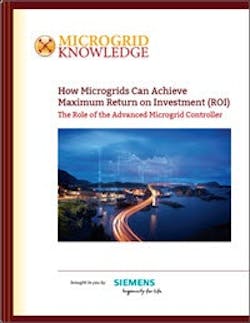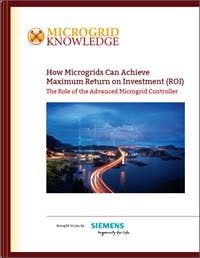No ‘killer app’ exists for microgrid financing. And until one is found, microgrid growth is unlikely to reach full steam, as we explain in “How Microgrids Can Achieve Maximum Return on Investment (ROI): The Role of the Advanced Microgrid Controller. Below is an excerpt.
The microgrid industry is expected to see rapid growth in the coming decade. Some describe it as the next market iteration of solar, which grew eight-fold from 2010 to 2015, and is forecast to expand by another 119 percent in 2016.
While many catalysts drive solar industry growth, analysts point to financing as a primary factor. The turning point for the solar industry came when it formulated financing models—such as solar power purchase agreements (PPA) and solar leases—that eased the strain on buyers and offered favorable returns for investors. Before that, solar had advanced slowly.
Today, the microgrid industry is much like the solar industry in the early to middle part of the last decade; microgrids have piqued the interest of investors, communities, governments, universities, businesses and others. But customers are unsure if they can afford them, and investors are unsure how to monetize them.
The Microgrid Knowledge Special Report on Microgrid Financing – Download it Now
Much of the problem resides within a microgrid’s complexity.
“There are novel nuances to microgrid projects (such as how to value resilience) that are not yet sufficiently understood by the market, and not sufficiently well-vetted to attract larger institutional investors,” say Jonathan Strahl, Emily Paris and Laura Vogel of Navigant Consulting, in their paper, “The Bankable Microgrid: Strategies for Financing On-Site Power Generation.”
Greater than the sum of its parts
Consider how microgrids compare with other energy assets, such as power plants or energy efficiency programs. Each of these offers a relatively straightforward product to create value: one provides electricity and the other electricity savings.
An advanced microgrid, however, offers both power supply and energy savings and derives value from each. And that’s just the start of the complex stream of economic benefits that can emanate from a microgrid; others include electric reliability, resiliency, energy security, emissions reductions and energy bill savings. In addition, many microgrids incorporate combined heat and power (CHP), which adds thermal economic benefits to the mix.
Perhaps most important, an advanced microgrid creates these benefits through a complex interaction of its distributed assets. (Often the interaction extends to the central grid, as well.) The microgrid derives its value from an interwoven complexity—and this is what makes quantifying value so difficult.
The microgrid derives its value from an interwoven complexity — and this is what makes quantifying value so difficult.
Again, let’s compare a microgrid to a power plant. Measuring the power plant’s value is like taking a yard stick to a straight line — one asset is considered. By comparison, measuring the value of a microgrid is more like plucking apart strands of a spider’s web and putting a ruler to each—but then realizing that length alone does not show the value of the interwoven web to the spider.
For investors, the microgrid value proposition is further complicated because no standard microgrid design exists. Instead, a microgrid is location specific and highly tailored to serve its customers’ needs. Customers benefit from tailored solutions, but investors do not, at least in the sense that microgrids become difficult to replicate in financial models.
A microgrid’s size also offers an example of a benefit to customers that daunts financial markets. Their ‘micro’ nature makes microgrids agile and able to serve pinpointed needs on the distributed grid. But financiers generally prefer large capital projects over smaller ones. It is as much work for them to finance a small project as it is a large project, but the large project nets greater profit.
Getting a microgrid down to one number
To be clear, microgrids are being developed and financed now. But no ‘killer app’ exists for microgrid financing, no one approach that fully realizes microgrids’ complexity and value to encourage wide-spread adoption. Instead, for each new microgrid, project partners find themselves engaged in the time-consuming task of figuring out a custom microgrid financing package. And while they can solve the problem for that particular microgrid, the solution is not widely replicable.
Like many new clean energy products, microgrids are relying in their early days on government grants for partial funding; the most notable of these programs being the $40 million New York Prize. However, government funding typically covers only a portion of costs. For the remainder, microgrids tend to rely on variations of financing models established for related industries. These include direct ownership, vendor financing, energy service contracts, power purchase agreements, leasing, debt financing, bonds, Green Banks and other common alternative energy vehicles.
Government funding typically covers only a portion of costs. For the remainder, microgrids tend to rely on variations of financing models established for related industries.
So what will it take for investors to craft a microgrid financing model that will accelerate growth, one that is not piecemeal but takes into account the entirety of the microgrid’s value? Is it possible to get a microgrid down to one number?
This guide posits that what’s missing is a ready way to establish return on investment (ROI), particularly for advanced or ‘optimized’ microgrids. It shows how an advanced microgrid controller can help establish ROI, and it offers a method for doing so.
“Every solar company can now quickly crank out a project’s value based on a few parameters, such as solar intensity, local utility rates and tax credits. In minutes they can price and produce a power purchase agreement for a customer,” says Sally Jacquemin, Siemens microgrid business manager. “The microgrid industry would benefit tremendously from a similar model. Establishing a ubiquitous way to determine ROI would go a long way in helping the financing community develop such a model.”
So how do we quantify the value of a microgrid?
Learn more by reading “How Microgrids Can Achieve Maximum Return on Investment (ROI): The Role of the Advanced Microgrid Controller,” made available for free download courtesy of Siemens.
About the Author
Elisa Wood
Editor-in-Chief
Elisa Wood is the editor and founder of EnergyChangemakers.com. She is co-founder and former editor of Microgrid Knowledge.

